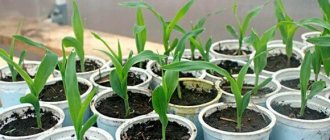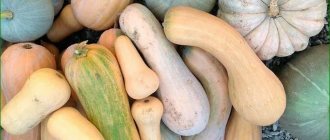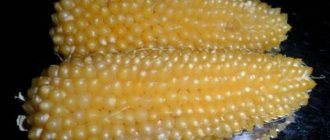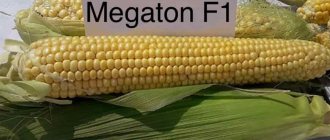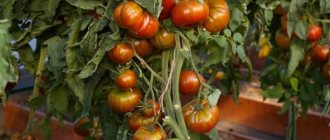Author's rating
Author of the article
Yakov Pavlovich
Professor, Head of the Department of Vegetable Growing
Articles written
153
Corn as a vegetable crop is divided into grain and sweet (sugar). Grain varieties are used for the production of corn flour and grits, alcohol, and fodder (livestock feed). Sweet corn is a popular vegetable for consumption fresh, boiled or baked, as well as for freezing and canning. A special variety (different from sweet, popping) is used to make popcorn. Due to the success of breeding and the emergence of very early hybrids, the popularity of sweet corn is growing among gardeners in the Middle Zone, the Urals and Siberia.
Characteristics of culture
Sweet corn is an annual vegetable crop grown for its tasty grain.
Nutritional value
Compared to the grain and popping varieties, unripe sweet corn seeds (in the milky-waxy ripeness phase) contain high soluble sugars (6-16%) and little starch. Also present: water (75%), fiber, unsaturated fatty acids, vitamins (mainly group B), mineral elements (selenium, zinc, chromium, iron). The calorie content of raw sweet corn is determined in the range of 81-86 kcal, boiled - from 96 to 130 kcal.
Biological features
The plants are herbaceous, tall (up to 2.5-3 m), with an erect stem. The fibrous root system for the most part goes deep into the soil by 35-50 cm; sometimes aerial roots appear above the root collar. Male flowers form panicles at the top of the shoots, while female flowers sit in the leaf axils. Typically, each sweet corn plant produces 1-2 ears.
Harvest
The cobs are suitable for harvesting at the stage of milky-wax maturity. It is important not to skip this period, otherwise the grains will become rough, hard and lose their juiciness. There are several signs that determine the ripeness of corn:
- You can determine the ripeness of the cob by looking at the corn silk. It turns from emerald green to yellow-brown.
- Another sign of ripeness is the color of the grains. They are painted white or yellow depending on the variety chosen. In this case, the grains fit tightly to each other, and the shell is easily pierced.
- The outer wrapping leaves of the head of cabbage become dry and begin to turn yellow.
Most often, the corn harvest begins in early August. It is best to harvest early in the morning.
Judging by the reviews, Lakomka Belogorye corn won one of the first places among experienced vegetable growers. It is noted that corn plantings are easy to care for during cultivation; almost all sown seeds germinate promptly and on time. The first cobs can be eaten after 90 days.
On one stem, 150 cm high, up to 4 ears can form. Vegetable growers also note the high yield of the variety; the plant does not require frequent watering; the grains of the collected cobs retain their juiciness and sweetness for a long time.
The best varieties of sweet corn
It is difficult to say how truthful suppliers of corn seeds for amateur gardening are when they talk about traditional hybrid breeding (non-GMO). Hybrid corn has such obvious advantages over simple varieties that controversial issues are unlikely to stop scientific progress. Breeders select for early ripening, increased sweetness, fullness of the cobs, stable yield, and immunity to diseases and pests.
INTERESTING! In addition to simple hybrids (F1), there are so-called double hybrids of corn (2 l) with the greatest tolerance to any stress.
Early and mid-early
Varieties with a short growing season are in demand in all growing regions, but are especially popular in areas with a continental climate. In the Central region, the Middle Volga, the North-West and the Urals, as well as Siberia, it is recommended to plant super-early and early corn. Mid-early varieties are also suitable for the Lower Volga region.
The period from germination to harvest is:
- super early hybrids - 75...85 days;
- early - 90...100 days;
- mid-early - 105...115 days.
Super Sundance 2 l
An ultra-early hybrid from French breeders. Tolerant to disease. Compact bushes grow up to 1.7 m. The length of the cobs is 20 cm, weight is about 200 g. Productivity is up to 16 kg/10 sq. m.
Legend (Legend) 2 l
A very early, disease-resistant, unpretentious hybrid originally from France. The bushes are low (1.7 m). 4 cobs 18-20 cm long weigh 1 kg. Productivity 18 kg/10 sq. m.
Honey Bentham 78 days 2 l
A very early hybrid of the international corporation "Sakata" with a stable yield (1 kg/sq. m). Adapts to various growing conditions and is successful in any summer. The stems are quite low (up to one and a half meters). The length of the cob is 15-17 cm, weight 180-280 g. The taste is excellent.
Spirit 2l
An early hybrid of Dutch agro with friendly ripening. On low-growing (1.4-1.6 m) bushes, cobs weighing up to 190 g are formed. The grain is large and very sweet. From 10 sq. m harvest 7.5-9 kg.
Children's treat
Non-hybrid early variety of Russian selection. Bush height 2 m. Ear length 24 cm, weight 270 g. Productivity 6 kg/10 sq. m. The grain is large. It is recommended to be consumed boiled.
Trophy 2 l
Mid-early Dutch hybrid with productivity 17 kg/10 sq. m. Super sweet, resistant to stressful temperatures. The ears are solid - 22 cm, 280 g. Bushes are two meters high.
Valmond 2 l
The newest mid-early hybrid of Krasnodar selection. The length of the stems is 2.1 m. The size of the cob is 24 cm, 240 g. The yield is 9 kg/10 sq. m. The taste of boiled products is excellent.
Gourmet's Dream 2 l
Mid-early hybrid from Russian. Plant height 1.7-1.9 m. Ear weight 230 g, length 19 cm. Productivity 6-12 kg/10 sq. m.
See also How to shell corn at home - making a homemade sheller
Mid-season
Medium-ripening sweet corn is ready for harvest 120 days after the start of the growing season. It can be cultivated in the Lower Volga region and the North Caucasus. There are interesting imported new items in this group.
Workhorse 2 l
A new hybrid from France with fairly massive cobs (up to 300 g) 25 cm long. Two-meter bushes produce a harvest of 190 kg per hundred square meters.
Liberton F1
Traditional hybrid from German breeders. Stems are medium tall (1.7 m). Ear size 24 cm, 255-270 g. Productivity 7 kg/10 sq. m.
Squeegee 2 l
French selection. On low bushes (1.5 m), super-sweet heavy ears (22 cm, 360-390 g) are formed. Bicolor coloring - yellow and white grains are adjacent. High-yielding hybrid (24 kg/10 sq. m).
Alina
Non-hybrid variety from Kabardino-Balkaria. The bushes are low (1.6-2 m). The average cob size is 20 cm, 173 g. From one hundred square meters you get 60 kg.
Late ripening
Ears of mid-late and late varieties reach consumer ripeness 125-140 days after germination. In Russia they are grown in the North Caucasus.
Royalty 2l
The mid-late hybrid was obtained in Holland. Tolerant to bacterial and viral diseases. The length of the stem is 2.2 m. The cobs grow up to 25-30 cm and weigh 350-400 g. From one hundred square meters, 120 kg of vegetables are obtained.
F1 athlete
Disease-resistant Crimean hybrid with stable yield (120 kg per hundred square meters), late ripening period. The cobs are not too long (20 cm), but heavy (up to 290 g). Boiled products have an excellent taste.
Generator 2 l
Late hybrid from France. The bushes are not too tall (2.1 m). The cobs are massive (25 cm, 325 g). The productivity of one hundred square meters is 160 kg.
Baksan sugar
This mid-late non-hybrid variety was obtained in Kabardino-Balkaria. The stems grow up to 2.5 m. The weight of the cobs is 340 g, the length is up to 18 cm. 140 kg are collected per hundred square meters.
Waxy corn
This variety of corn contains no monosaccharides at all. Due to this feature, wax grains are absorbed more slowly by the body. As a result, blood sugar levels decrease, well-being and performance improve. This type of culture is useful for diabetics.
Black wax
The plant grows in height up to 1.7 m. The heads of cabbage are medium or small, reaching a length of 10-20 cm. The original color of ripe grains is greenish-black.
White Dakota
An early ripening variety, the plant reaches a height of 1.8 m. The ears are small, up to 14 cm, their shape is pyramidal, the grains are small and white. Suitable for baking, boiling and freezing.
Early pink glow
An early variety, reaching a height of 1.4 m. Small cobs have a pyramidal shape and grow up to 14 cm. The shade of the grains is lilac or pink.
Features of cultivation
It is not difficult to obtain a decent harvest of sweet corn if you know the intricacies of agricultural technology.
Favorable regions for planting
The homeland of the corn plant is tropical and subtropical America with plenty of heat and sun. The advancement of culture to the north faces objective difficulties (long growing season).
In Russia, industrial plantings of sweet corn are located in warm regions:
- in the Central Black Earth Region;
- on the Lower Volga;
- in the North Caucasus;
- in the south of the Far East.
In more northern zones, this crop is grown by gardeners for private consumption. Here, a relatively short frost-free period dictates the choice of varieties and hybrids of corn with the shortest growing season (early and mid-early assortment). Crops are carried out under temporary shelters and in insulated beds; The seedling method of cultivation is also used. They have learned to produce sweet corn of consumer ripeness in the gardens of the North-Western region, the Middle Zone, the Urals and Siberia.
Choosing a location taking into account crop rotation
The uniqueness of corn is that it can be grown for many years in a row in one place. It is not recommended to place after potatoes, sunflowers, and melons.
Corn bears fruit only in well-lit areas. Drought-resistant, but responsive to watering and fertilizers. Prefers light nutritious soils, neutral and slightly acidic. Lands with acidity below pH 5 require preliminary liming. Poor soil is filled (for digging to a depth of 25 cm) with semi-rotted humus or mature compost (4-7 kg/sq. m) and complex mineral fertilizer (30 g/sq. m).
Sowing dates and patterns
Sweet corn seeds can be sown dry (especially if they are processed hybrids) or pre-soaked in water for 6-12 hours. For successful germination, it is necessary that the soil is moist and warmed up to at least +12 degrees (optimally up to +23...+28 degrees). In the central zone, sowing in an insulated bed is carried out in the first ten days of May. Corn seedlings can die at temperatures below -3 degrees, so they need to be covered with agrofibre if there is a threat of return frosts.
The sowing depth of sweet corn is from 4 to 6 cm. When single-row planting, 20 cm is left between the bushes. The layout of plants on the plantation is 60-70 cm X 25-30 cm. For late-ripening, tall varieties, the row spacing is increased by one and a half to two times.
INTERESTING! In the northern regions, you can resort to seedling technology for growing sweet corn. Seeds are sown for seedlings at the same time as cucumbers (from the third ten days of April to mid-May). Each plant is given a separate 300 ml pot. Seedlings are planted outside or under temporary shelter at the age of 2-3 weeks, providing protection from frost.
Landing
Corn is considered a light-loving crop. You need to choose a sunny area, away from the shade of trees and fences, preferably on the south side of the house. In this case, the site must be protected from through winds.
The best precursors for corn are legumes, potatoes, cucumbers, tomatoes, onions, and fodder beets. Corn should not be sown after millet and cabbage.
Corn does not have any special requirements for soil composition, but podzolic, peat and chernozem soil is best suited. The vegetable crop does not tolerate low-lying soils with poor water drainage.
In the fall, during land preparation, it is advisable to apply organic and phosphorus-potassium fertilizers. In the spring, they loosen the soil and walk through the area with a rake, breaking up large clods of earth.
Corn seeds of the Spirit variety or any other type are sorted before planting, only healthy and dense ones are selected, soaked in growth stimulants and disinfected. It is advisable to warm the seeds in the sun for 5 days, then soak them in hot water. This procedure will speed up seed germination.
See also
Medicinal properties and contraindications of corn silk, their useRead
Corn is sown in mid-May, when the threat of frost is behind us. By this time the soil should warm up to +10 degrees. The day before planting the seeds, you can apply nitrogen fertilizers. Before planting, the soil must still be loosened to a depth of 10 cm.
They begin to sow corn in open ground at the end of April or early May. The first shoots should appear on days 10–12. In the prepared area, furrows are made to a depth of 7 cm. If the area is small, then rows are made at a distance of 60 cm.
Grain crops for seedlings begin to be sown in early May; it is best to plant the seeds in separate peat pots. In this case, there will be minimal risk of damaging the root system during transplantation. Already in mid-June, they begin to transplant seedlings into open ground. By this time, three true leaves should appear on the seedlings.
How to care for Dutch corn
Dutch sweet corn hybrids are genetically tolerant of various stresses and therefore do not require much gardener attention. But even minimal care leads to faster ripening of the cobs and increased yield. Hybrids set well, but it is still useful to periodically shake the bushes during the flowering phase for better pollination.
See also Corn: botanical description and origin of the culture
Loosening and mulching the soil
Immediately after sowing, the soil is lightly rolled and mulched so that the soil crust does not interfere with seedlings. The first (shallow) loosening of the plantings is carried out when the young corn puts out 3-5 leaves. When they grow up to 70 cm, the bushes are lightly hilled and mulched with light compost.
Watering and fertilizing
Corn has the greatest need for moisture:
- in the germination phase;
- when throwing out panicles (male flowers);
- 15 days after the release of the pistil filaments from the female ovaries;
- during the formation of grains;
- in the initial stage of fruit filling.
It is possible to grow sweet corn without watering if it rains regularly. When the soil dries out, it is advisable to water the beds, soaking the soil to a depth of at least 30 cm.
It has been noticed that fertilizing increases the yield of sweet corn by 1.3-2 times.
Fertilizer irrigation schedule:
- When promoting male panicles, nitrogen and potassium (aqueous solution of manure 1:10 + ash or 20 g of Urea + 15 g of Potassium Sulfate per bucket of water).
- When the pistillate filaments come out, nitrogen and phosphorus (water infusion of bird droppings 1:20 or 20 g of Ammophos per bucket of water).
A bucket of nutrient solution is distributed over 2 square meters. m of the root zone.
Expert opinion
Stanislav Pavlovich
Gardener with 17 years of experience and our expert
Ask a Question
IMPORTANT! Root fertilizers are given only on wet soil.
Protection from diseases and pests
Hybrid Dutch corn is quite disease resistant. However, to prevent root and stem rot, you can spill the soil with a biofungicide (Sporobacterin, Trichocin, Trichoderma Veride) 5 days before sowing.
Corn roots are damaged by insects such as wireworms. In areas massively populated by these larvae, before sowing corn, pesticides containing the chemical diazinon - Provotox, Zemlin, Pochin - are applied to the ground.
Biological pesticides (Fitoverm, Iskra Bio) are used against corn aphids and stem borer caterpillars.
Technology for growing crops in open ground
It is recommended to grow sweet corn away from regular corn, as cross-pollination reduces the sweetness of the kernels. This heat-loving crop prefers well-lit areas. Corn seedlings die at temperatures of 3 degrees below zero. The optimal temperature for the growth and development of this crop is 15-22 degrees Celsius.
This is a short-day plant that thrives in northern latitudes. Corn is a cross-pollinated crop. Caryopsis fruits ripen if pollen from the upper panicle falls on the pistillate filaments emerging from the involucre of the cob. Male panicle flowers bloom 3-5 days earlier than female ones. Corn usually blooms in July-August and ripens in September-October. Early hybrids ripen already in early August.
Soil requirement
To obtain a high yield, the soil must be fertile and neutral or slightly acidic. This unpretentious crop can grow on almost any soil, even on peat bogs and soil saline with chlorine salts. However, it prefers light and well-warmed soil. Loams and sandy loam soil are suitable for corn.
Optimal soil composition: garden soil, leaf soil, turf soil, peat, sand.
Corn can be planted after wheat, rye, tomatoes, potatoes, cabbage, legumes and melons. Often grains are sown in cucumber beds.
Preparing the planting site and seed material
The area for planting corn is prepared in advance. Starting in the fall, the soil is dug up to a depth of 25 centimeters and humus and potassium-phosphorus fertilizers are added. For 1 square meter of land take 5 kilograms of organic matter, 50 grams of superphosphate and potassium salt. In the fall, the ground can be sprayed with a solution of Roundup (to kill weeds).
In the spring, the area is loosened to a depth of 10 centimeters, leveled, harrowed, and large lumps are broken up. The day before planting, nitrogen fertilizers (nitroammophosphate, ammonium nitrate) are applied to the soil. Approximately 50-100 grams per square meter.
Before planting, the grains are soaked in warm water for a day, then disinfected for 20 minutes in a pink solution of potassium permanganate. For 4 days, the seed is placed in damp gauze bags. When tiny roots appear, the seeds are planted in the garden. Hybrid seeds are sold already treated against diseases and pests; they are immediately sown in the ground. The first shoots appear on days 8-12.
Landing dates and rules
Seeds are sown when the soil warms up to 10-12 degrees Celsius. The grains are buried 6-8 centimeters into the soil. The soil must be well moistened before sowing. Corn is usually planted in late April or May. Early hybrids are sown first; they are cold-resistant. Seeds are sown in rows.
See also
Description and selection of corn seeds, how to save at home
Read
The grains are sown using the square-cluster method. The distance between them should be 0.5-0.6 meters. Between plants of the same row, leave 0.35-0.50 meters of free soil. 3-4 grains are sown in one hole. Typically corn is grown in 4 rows for cross pollination.
Some hybrid varieties are grown by seedlings. In this case, the grains are sown in boxes with fertile substrate at the end of March. In May, when the air warms up to 15 degrees Celsius, the seedlings are transferred to the garden bed at the age of 30 days.
Corn care
After 3-4 true leaves appear on the sprout, the planting is thinned out. A distance of 0.35-0.50 meters is left between neighboring plants. The corn must be hilled so that the stalks do not lie down. 3 weeks after germination, corn plantings are fed. It is best to add rotted humus and compost to the soil.
If there are no organic fertilizers, you can feed the crop with ammonium nitrate, superphosphate and potassium sulfate.
The first time after planting, corn grows very slowly. During this period, you need to regularly loosen the soil, break up the soil crust, and remove emerging weeds from the garden bed. After the 8th leaf appears on the stem, more intensive growth begins. In a day, the shoot can grow by 5 centimeters. During this period, the leaves are sprayed with a weak solution of urea, and superphosphate and potassium substances (35 grams per 1 square meter) are added between the rows.
If lateral stepsons appear on the stem, they need to be torn off. During the period of ear laying, the crop needs abundant watering. After all, in a drought, juicy fruits will not form. It is recommended to water the beds daily; the soil should not dry out or crack. However, it is not advisable to flood corn plantings with water. In swampy soil, the crop will begin to hurt and rot.
Fighting diseases and parasites
Sweet corn gets sick more often than other grain crops. Diseases cause significant damage to corn crops. They can negate all the efforts of gardeners and reduce yields.
Mold on grains and sprouts is a common fungal infection. A blue-green or white-pink coating appears on the grains, and the sprouts turn brown. The disease can be triggered by increased humidity (rain) and decreased air temperature. Due to the fungus, not all grains germinate; deep planting of seeds on heavy clay soils contributes to the spread of infection.
To combat fungal diseases, preventive spraying of grains with fungicides (Maxim, Real 200) is carried out just before sowing. Seeds are sown in warm, dry weather. The soil can be pre-treated with a fungicide solution (Fitosporin, Bordeaux mixture).
There are hybrids that are resistant to fungal diseases, for example, Boston F1, Lukomorye F1, Dzhumbili F1.
Bladder smut is a fungal infection that affects all parts of the plant, but it causes the greatest harm to the cobs. On organs affected by the fungus, dark swellings appear, covered with a grayish film, the contents of which consist of spores. The fungus lives in the soil and becomes active in rainy weather that turns into drought. At such a time, the culture weakens, its immunity decreases.
Bladder smut is commonly found in areas where corn kernels are sown after corn. Fungicides (Maxim, Vitavax) are used as prophylaxis. They are used to treat grains before sowing. It is imperative to observe crop rotation and destroy weeds after harvesting.
Loose smut is a fungal infection that affects only panicles and ears. The disease turns these parts of the plant into a dusty mass consisting of spores. The stems grow poorly and have a depressed appearance. The cobs turn into a dry, cone-shaped black lump. The disease is very dangerous, as fungi become more active in warm weather. Spores live in the soil for a long time. Can be blown by the wind. To prevent disease, grains are treated with a fungicide (Vitavax, Maxim) before sowing.
To combat infection, it is recommended to maintain correct crop rotation and remove weeds from the field in a timely manner.
Fusarium is a fungal infection that affects cobs. A white-pink coating of fungus appears on the grains. The infection destroys the grains. The fungus lives in the soil and is spread by insects (corn borer). The disease becomes more active in rainy weather. For prevention, plants are sprayed with a solution of the fungicide Fitosporin-M.
Helminthosporiasis is a fungal disease that affects leaves, stems, roots, and sometimes cobs. Elongated brown spots with a dark border appear on the leaves. With severe infection, the leaves dry out. If the fungus penetrates the roots, the plant wilts. The infection becomes more active in warm and rainy weather. For prevention, plants are sprayed with a fungicidal solution; it is recommended to treat the grains before sowing.
Root (stem) rot is a fungal disease in which the crop suddenly withers, the stems fall down, and the leaves dry out. The infection becomes more active in rainy, warm weather. The fungus attacks weakened plants that lack potassium-phosphorus substances. To prevent infection, grains are treated with a fungicide solution before sowing.
Sweet corn is often attacked by insects. For example, the wireworm, a yellowish larva of the click beetle, eats up grains and damages the underground part of the stem and roots. To combat these worms, the soil is watered with insecticidal solutions (Regent 20 G) before sowing.
The corn borer is a gray-brown butterfly. Starts flying at the end of June. Lays tiny eggs from which caterpillars emerge. Insects feed on leaves and stems and gnaw holes in them. To protect the plants, they are sprayed with insecticidal solutions (Bitoxibacillin, Lepidocid).
Harvest and storage
Consumer ripeness of sweet corn occurs approximately 25 days after the formation of pistillate filaments on the cob. For the Middle Zone this is the second half of August or the beginning of September. It is advisable to harvest before frost. The cobs are removed selectively, carefully breaking them off at the base.
INTERESTING! It's best to harvest corn in the evening or morning because cooler temperatures make the grain sweeter.
Hardening and biological ripening of seeds should not be allowed. They are brought only to milky-waxy ripeness: the grains become full-bodied, full, shiny, smooth, elastic, but remain juicy and moderately soft, and acquire the color typical of the variety. The pistillate threads darken and die, the integument of the cobs begins to dry out at the edges.
Expert opinion
Stanislav Pavlovich
Gardener with 17 years of experience and our expert
Ask a Question
IMPORTANT! Overripe grains of sweet corn become dull, hard, and do not release juice when pressed. They soften poorly even after prolonged cooking.
For transportation and storage, cover leaves are left on sweet cobs or peeled vegetables are wrapped in cling film. In a cool, not too damp room (or in the refrigerator), fresh harvest is stored for 6-10 days.
INTERESTING! For long-term storage, raw or boiled corn is frozen as whole cobs or grains.
Care
During the entire period of growing sweet corn, you need to follow some recommendations. The first time after planting the plant grows slowly. At this time, loosening and weeding will benefit him. Rules of agricultural technology:
- Corn requires abundant watering. The size of the cobs and the sweetness of the grains directly depend on the correct watering regime. Particularly a lot of moisture is required during seed germination and cob formation.
- Loosening the soil is carried out after each watering and after rain. The higher the plant becomes, the shallower the soil loosening depth. This will reduce the risk of damage to adventitious roots.
- During the flowering period, an additional pollination procedure can be carried out. To do this, they pick off the male flowers (they are located at the top of the stem) and shake them over the flowering ears (the female flowers are located here).
- To speed up the growth of the plant and the formation of the cob, pinching is carried out. All side shoots are trimmed.
- Weeds should not be allowed to grow, so timely weeding is carried out.
- Carry out preventive treatments to protect against pests and diseases. At the first signs of their appearance, measures must be taken to preserve the harvest.
A special place is occupied by the application of fertilizers. Corn responds well to compost and humus. The first fertilizing can be done when the plant has 5-6 leaves. After the fifth leaf unfolds, potassium fertilizers are applied. A liquid solution of ammonium nitrate and superphosphate can be added to the row spacing.
If the leaves become pale green and have yellow veins, it may be necessary to add nitrogen components. If the edges of the leaves begin to turn yellow and dry, you need to add potassium.
Conditions for growing sweet corn
Sweet corn is classified as a heat-loving and heat-resistant plant. The minimum temperature at which seeds can begin to germinate is + 5-7 °C. But optimal temperatures for normal growth and development of plants are + 24-28 °C. Although too high air temperatures (above + 33 ° C) are also unfavorable, especially during the flowering period of corn. They can have an adverse effect on the quality of the ears being set, and on the yield in general. In addition, if temperatures remain too high during the ripening period, the sugar contained in the grains can quickly turn into starch.
Corn is a light-loving plant; it needs at least 12 hours of daylight. She does not tolerate the slightest shading, especially at the beginning of growth. Therefore, it is important to provide plants with protection from weeds that may shade them from the sun. And without a sufficient amount of sunlight, the harvest may not wait at all.
Sweet corn is more than tolerant of the moisture content in the soil, being a drought-resistant plant. But it does not tolerate excess moisture well, especially if it grows on heavy, clay soils. But during the flowering period, plants still require a sufficient amount of moisture, so watering at this time is very desirable for them.
Good predecessors for sweet corn in the fields are various grains or legumes, and in personal plots - root crops, tomatoes and melons.
Pests and diseases
Hybrid varieties of corn that are presented on the market have increased productivity and early maturity (all the secrets of high yield per 1 hectare can be found here). Not the least of their value is resistance to disease. But you need to know the enemy by sight. What diseases affect the sun-loving beauty?
Most often these are fungal diseases:
- Diplodia is easy to notice - brown spots appear on the lower part of the stem. At this point, the plant tissue becomes soft, the stem breaks, and white mycelium can be seen near the leaves. The only way to combat diplodia is to treat the area with a fungicide before planting corn.
- Fusarium affects ripe cobs. You can notice a coating on the grains, which is a harbinger of rotting. Plants infected with the fungus must be removed from the site and burned, and after harvesting and before replanting seeds, the soil must be treated with a fungicide.
- Corn rust can be identified by characteristic tan spots on the bottom of the leaf. To prevent this type of disease, it is necessary to treat young shoots with a fungicide.
Sweet corn needs to be protected not only from diseases, but also from the following pests:
- Swedish fly larvae damage young shoots of corn, and the plant dies in this case. The method of pest control is treatment with an insecticide, as well as seed dressing.
- Corn borer caterpillars damage cobs and can cause fusarium blight. It is noteworthy that these pests can overwinter in corn plants at temperatures as low as -25 °C. The method of controlling caterpillars is treatment with an insecticide during the mass flight of butterflies.
We invite you to learn more about all diseases and pests of corn, including bladder smut, which is also called Mexican truffle.
Varieties and hybrids
Sweet corn is the most profitable crop, and when choosing seeds, the timing of the product's release to the market is of paramount importance, which determines the selling price. Judging by the experience of Russian farmers in recent years, the most profitable varieties are early and late ripening varieties. Among varieties for fresh consumption, foreign hybrids play a dominant role, which is explained by the good preparation of seeds separately from grains for industrial use.
You can obtain consistently high yields and extend the harvest time by sowing in the following ratios:
- early ripening - 20%;
- mid-early - 30%;
- mid-season - 30%;
- mid-late - 20%.
Early corn has a growing season of 60-90 days, medium - from 91 to 105 days, late - from 106 days. Domestic experience has established the following varieties and hybrids with potential high yields: F1 Super Sundance, F1 Spirit, F1 Legend, F1 Trophy (60-75 days from germination), F1 Challenger, F1 Bonus, F1 Merkur, Kuban Sugar 210 (75-90 days ), Ice nectar (late-ripening, especially sweet variety).
Delicious dishes with corn Spirit F1
There is a wide variety of recipes where sweet corn of any variety can be used, including Spirit F1.
A simple recipe for cooking corn in a steamer
The cobs are cleared of leaves, washed with cool water and dried with a towel. Water is poured into the bowl, and the cobs themselves are placed for steaming. Close the lid and set the time to 35 minutes. After the finished corn has cooled, the cobs are greased with butter, sprinkled with salt and served.
Corn fritters
To prepare, you will need cornmeal and canned sweet corn. Drain water from canned grains. Add kefir to a separate bowl, dilute flour in it, add salt, sugar and soda. All ingredients are thoroughly mixed. Add canned corn kernels to the resulting dough and begin frying. Use a spoon to measure out a small portion of the dough and place it in the pan.
Corn soup
Finely chop the peeled onions, chop the peeled carrots and celery using a grater. Potatoes and zucchini are cut into small cubes.
Melt butter (20 g) and vegetable oil (25 ml) in a saucepan, and then add chopped onion, frying until golden brown. After this, add carrots and celery, and after a couple of minutes, potatoes. Vegetables are poured with a liter of boiled water.
5 minutes after boiling, add zucchini and canned corn to the vegetables along with the liquid in the jar. After this, cook for another 10 minutes. At the end of cooking, add salt, spices and grated processed cheese.
It is recommended to grind the finished soup in a blender until smooth. The finished dish can be decorated with herbs.
Salad with corn and mushrooms
Boil chicken fillet in salted water. The champignons are washed and cut into small cubes. Fry the chopped onion in heated vegetable oil until golden brown, then add the mushroom cubes. After 15 minutes of frying, add salt and pepper to the onions and champignons.
The hard cheese is grated, the water is drained from the canned corn, the chicken fillet is removed from the broth and allowed to cool. After this, the fillet and canned pineapple are cut into small cubes.
Then they begin to form the salad. The first layer in the salad bowl is chicken, then onions and mushrooms. Place corn and chopped pineapple on the mushrooms and cover everything with mayonnaise. Top everything evenly with cheese.
